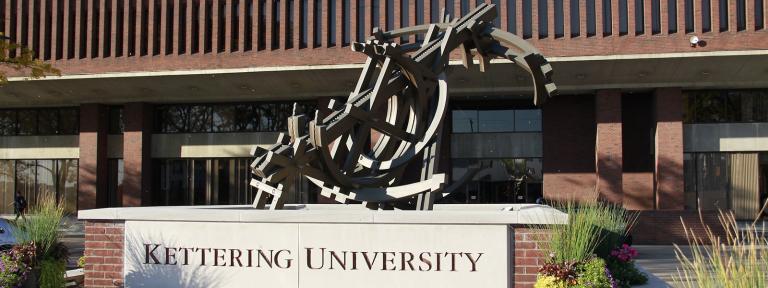
“I believe it is going to have a very strong impact on our campus and that it will become a part of the iconography of the institution.”
Kettering University’s campus is about to get an infusion of art into its public spaces as the school has installed the Orbits of Isaac sculpture by Michael Dunbar in front of the Campus Center along N. Chevrolet Avenue. The University believes the sculpture will become an iconic centerpiece of the campus and a visual statement of the university’s commitment to the arts and humanities as a critical part of creating a holistic learning environment for its students.
Orbits of Issac is a highly technical, 12’ x 12’ x 14’ outdoor bronze sculpture that makes a strong statement about the connection between engineering, design, and the arts.
“It’s a highly engineered, intricate, and beautiful sculpture that harnesses inspiration from the sciences,” said Kettering University President Robert K. McMahan. “I believe it is going to have a very strong impact on our campus and that it will become a part of the iconography of the institution.”
Dunbar himself was on hand for the installation and may spend time at Kettering in the future to share his techniques and assist students in applying their design and engineering skills to the production of sculpture as a way to inspire them in their work both inside and outside the classroom. For the same reason, Kettering has also established collaborative programs with the Flint Institute of Arts and Flint Institute of Music for its students.
“The addition of this piece on campus is a visual statement of our belief that the heart of creativity lies at the intersection of the technical with the artistic,” said President McMahan. “Students at Kettering are among the brightest and most successful in the country, but what many often do not appreciate is that they are also artists, musicians, and writers. There is a strong correlation between science, mathematics, and engineering and the arts, and it is embodied in the talents of many of our students.”
Orbits of Isaac is named after physicist Isaac Newton, who is best known for formulating the laws of motion and gravity. Dunbar is a highly regarded sculptor known for producing grand structures that amalgamate science and art.
“There are several outstanding features to these works not the least of which is their complexity of design,” said John Henry, Director of the Flint Institute of Arts. “They are muscular compositions of intersecting arcs, beams and gears that when put together, create these dynamic instrument-like sculptures which seem to have a purpose and are ready to spring into use.”
“He’s been very consistent for many years proving his mastery of concept and materials,” Henry said. “The precision of his sculptures, both large and small, is remarkable. He’s taken his craft to the highest artistic level to create complex forms that appear to have some secret function, with some giving the impression of just coming to rest after being in motion. That’s what his work is all about.”
Henry describes the “zero tolerance” curves and cog-like teeth on the piece and also labels Dunbar’s work as “highly imaginative … evoking different feelings and ideas by the observers.” The enigmatic forms are open for interpretation as viewers envision the structure’s artistic components as well as its potential usefulness as some highly engineered tool.
“The installation of Orbits of Isaac is something on which we intend to build as an institution,” McMahan said. “We have abundant green space on campus and we hope to continue to use our public spaces in a way that exposes our community to the types of creative and thought-provoking visual art and design that will inspire our students.”
The sculpture will officially be dedicated on Thursday, January 16, 2013. Check Kettering.edu and follow Kettering on Twitter and Facebook in the coming weeks for more information about the dedication ceremony.